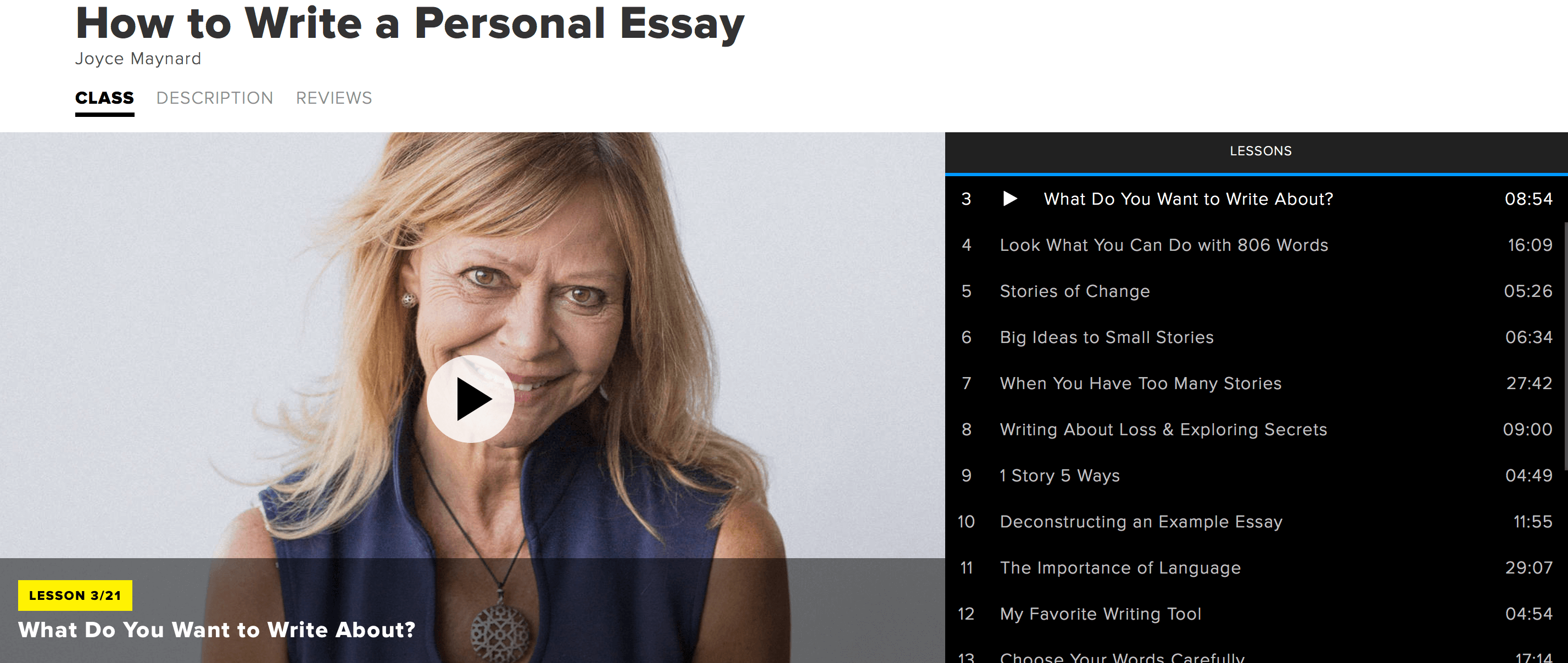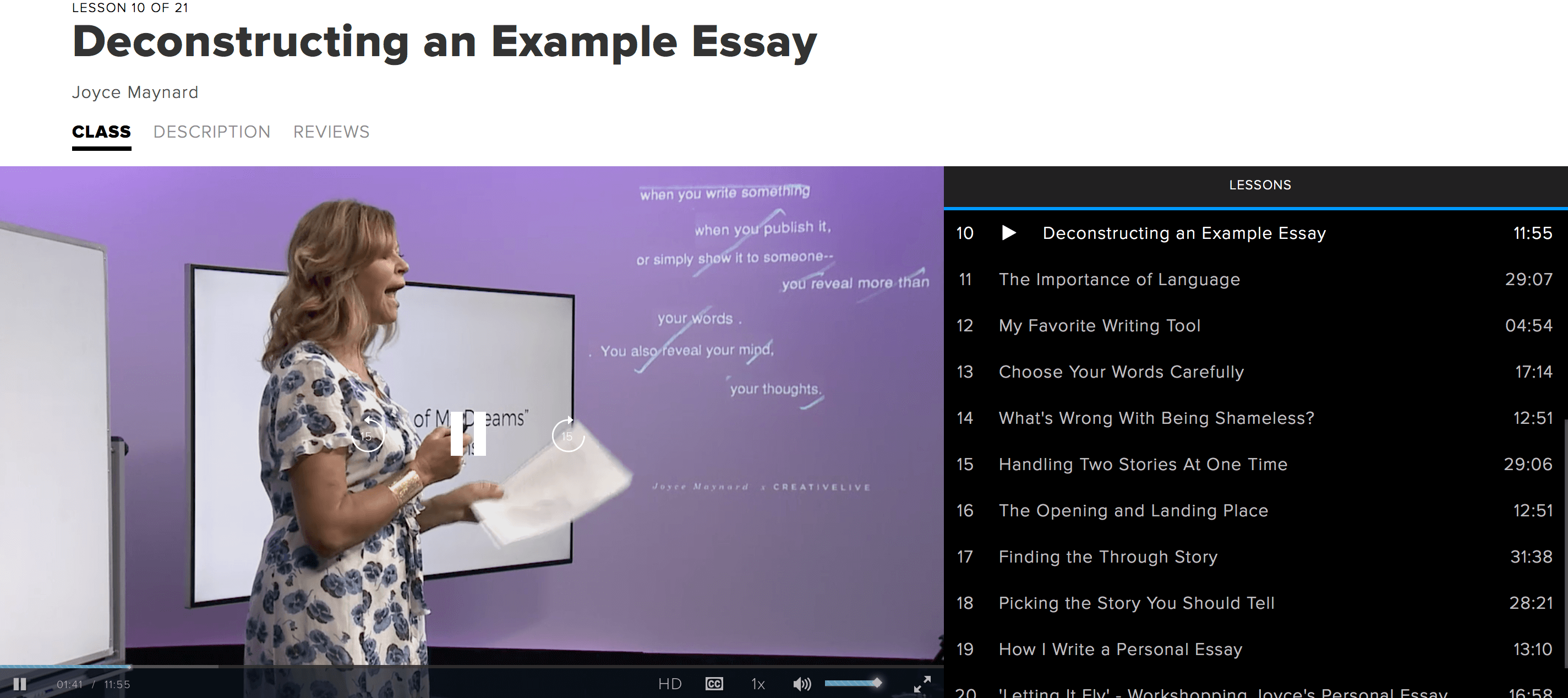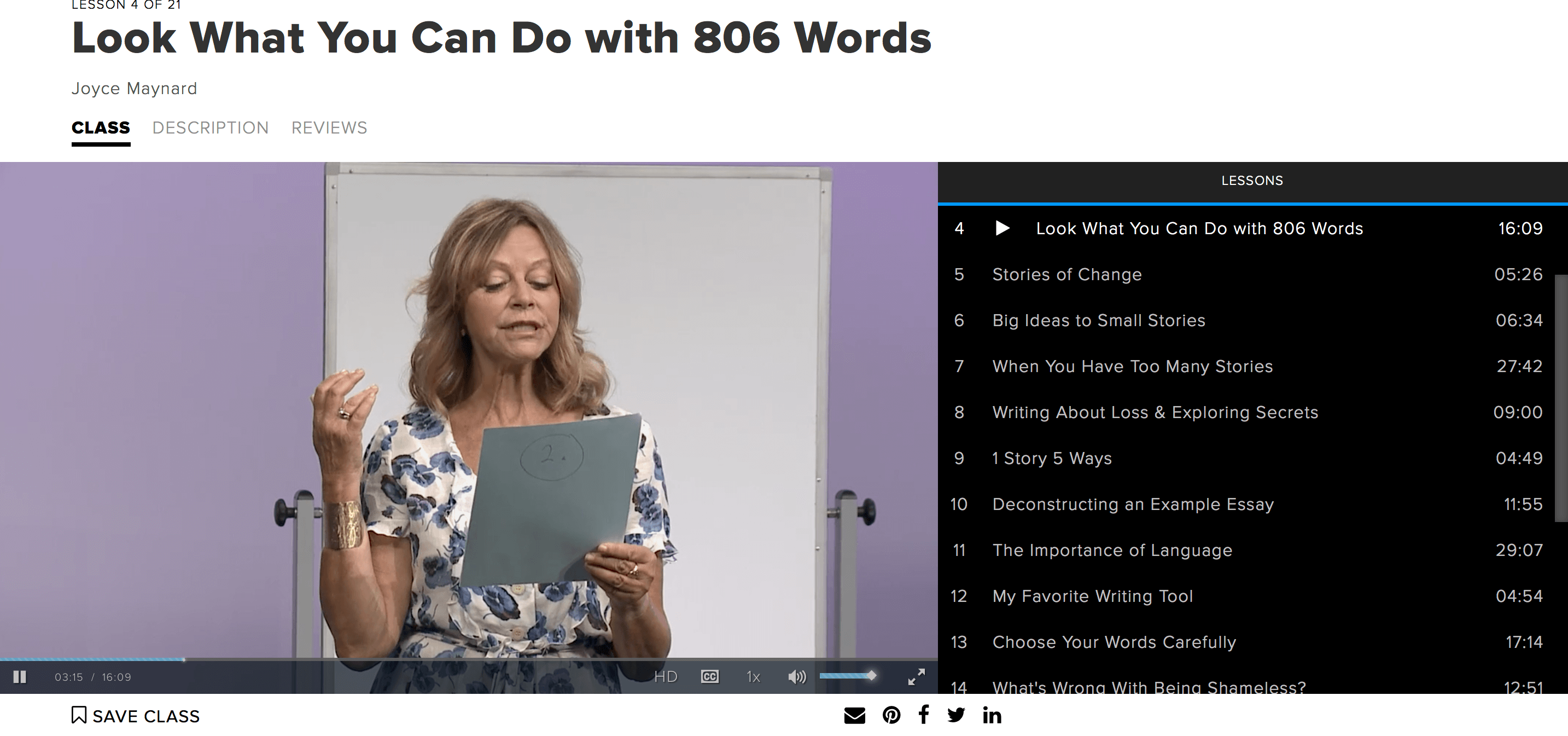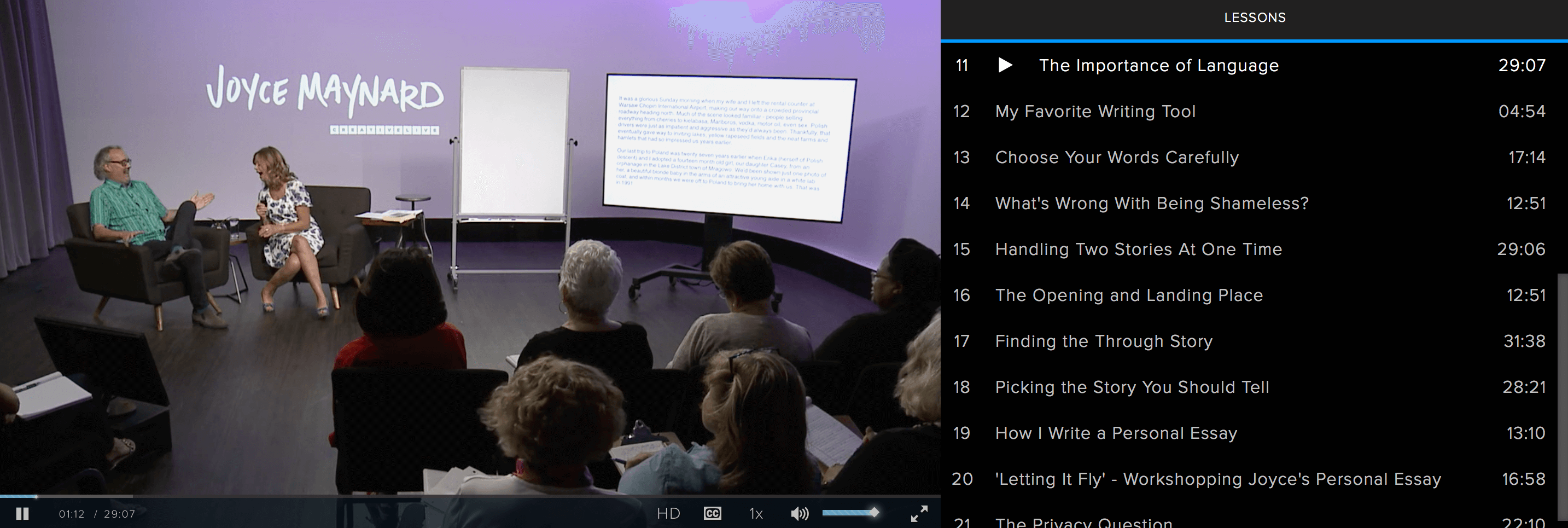I’ve been doing a lot of thinking about my online writing.
For a long time, I’ve mainly written reviews and how-to articles that aim to give advice for people who want to improve their lives.
- I’ve given study advice
- Reviewed books and courses
- Reviewed my favourite supplements
- Talked about how people can get into shape
- Written about how people can get into writing
- Written about how people can learn languages
But recently I’ve been wanting more nuance to my online writing.
I want to give something more personal, something more artistic.
A piece of evergreen art, not “content”, that I can be proud of.
The kind of thing people will bookmark and return to (like I used to do with long essays in literary magazines).
The kind of thing that could be in a book of personal essays.
Enter Joyce Maynard’s Creative Live Course: How to Write a Personal Essay
So I was thrilled to see Joyce Maynard, a writer whose work I’ve long admired, was giving several writing classes in the Creative Live catalogue.
I went for How to Write a Personal Essay.
I was pumped going into this class because there was already a 100% positive review history for Joyce’s class.
And I can see why.
What is Joyce Maynard like as a teacher?
Joyce Maynard is a perfect teacher for me.
Probably for most other people too.
But talking about myself, THIS is the standard of teaching to which I personally aspire to be like.
Joyce is so personable and friendly that it’s easy to forget you’re watching Joyce on a screen and not actually in the class with her.
She has a phenomenally positive energy, which is uplifting and calming at the same time, which cannot be faked. There are plenty of instructors who try to fake their energy and that’s something that always turns me off.
But Joyce is super genuine and I feel so aligned with her as she’s teaching. I think this is super important because it makes you more invested in the class, more likely to absorb the lessons, and more likely to put in the work.
Also Joyce has the experience to back up everything she talks about. She’s learnt all of this through a very fulfilling career in writing.
Not only that, but her students have been successful with many of them being able to publish in The New York times only after they’ve worked with Joyce.
If you’re not familiar with Joyce’s work, by the way, check out this essay she wrote for The New York Times’ Modern Love column:
What’s Joyce Maynard’s Creative Live class all about?
When you take Joyce Maynard’s Creative Live class, you’re aiming to use the personal essay as a “training ground” for sharpening the skills you need for bigger works like the memoir.
So if you’ve always dreamed of penning your memoir but find it too daunting, this is a great place to start.
And once you’ve sharpened your writing tools here, Joyce also has a course specifically aimed at memoir writing (I haven’t taken that one yet, but I’m sure it’s as fabulous as this one).
After a great introduction, one that gets you excited to start writing, we learn about what a personal essay is and is not, the reasons for writing a personal essay…
How to Write a Personal Essay
Personal essays are not a lot of things.
For example, they’re not a rant, an anecdote, a tribute to someone you love, they are not a poetic reverie or journal entry.
Essays are about story and change and motion.
The personal essay showcases a piece of your unique human story that you own, it’s stuff that is least likely to have been shared by anyone else.
The aim with this course is to go from trying to tell everything to telling one story really well.
The syllabus is superb and kicks off with a great module on where you get your ideas from.
The place to start with ideas when it comes to the personal essay is to evaluate your areas of expertise on yourself.
What are your themes?
What are your passions?
What are your obsessions?
Obsessions are a good place to start because they can get us into trouble (obsessed with food, shopping, etc.)
Go to your obsessions in writing – especially the ones that created a lot of issues and challenges in your life.
What are the obsessions that haunt you again and again?
I’ll list some of mine:
- Intimacy (sex)
- Classic literature
- Japan (the countryside particularly)
- Painkillers (in all their forms, anything to numb the pain)
You find these themes, themes that are so plentiful in your life that you could write a whole collection on them, and then you link them to a story.
What else could I write about that are BIG topics?
Ask yourself that.
Personal essays are all short stories about big ideas.
Personally I could write a short story with big ideas about: mental illness, depression, anxiety, culture shock, the ebbs and flows of love, self-love, meditation, finding god, family, race, women.
But the problem is when you make a list of these big topics, you won’t remember them because they’re TOO big.
You need to niche down and discover the particular stories that highlight these themes.
Before you begin to write, decide what the piece is about. And I don’t mean “my life”. I don’t mean “my divorce”. I don’t mean “my growing up in the midwest”, but a particular journey. Not just a state of being, but an experience of change. (Joyce Maynard)
The more I write, the more I realised the importance of this.
I’ve started screenwriting and above all else you need to know your longline, your 10-second blurb/elevator pitch, before you write a single word of story.
This is my number one piece of advice in my own writing course for writing a personal statement.
Know what you’re writing about before you put pen to paper!
The elements of the essay:
Joyce calls the point of entry “the moment before the curtain goes up”.
We need to know what life was like before the moment of change took place.
So if your house burns down (and the story is about that), we need to know what the house meant to you before it burnt down.
I really love this piece of advice.
I’ve taken a lot of writing courses, but perhaps due to the fact that this genre is still new to me, I’m finding that Joyce’s advice is unique and gets my mind thinking creatively in ways I haven’t before.
It’s so easy with writing courses to hear the same old advice over and over again. You don’t get that with Joyce. Her lessons are as unique as her writing and life stories.
Joyce also talks about how to get over the problem of having to talk about yourself.
This is a worry for a lot of writers who fear they’re not interesting enough, but I love the advice Joyce gives here about how to get over that.
Every person who is willing to honestly explore their experience is going to have a story to tell. (Joyce Maynard)
We get into character.
Of course, in a personal essay the main character is you.
But the problem isn’t “who is the main character?” But rather “what part of you are we going to explore?”
Joyce also talks about stakes – “What did I want?” – and they have to be significant enough that we’re going to care.
Ask yourself if the stakes are high enough for your story:
- Am I going to get a cat? No.
- Will I get this job? Maybe.
- Am I going to survive this medical crisis? Yes.
- Will my marriage endure? Yes.
- Will my child get off drug? = Real stakes
What is at stake?
What do you want?
And what is getting in the way?
Intention and obstacle! What’s the conflict? What’s the problem?
One of my favourite aspects of this course is the close analysis we do with Joyce when she shares her favourite essays with us.
There’s this one essay that’s just 806 words, but in a module that’s the same length of a tv show, we go deep into what makes it special.
This kind of content truly speaks to my inner geek.
I get way more value out of time spent dissecting a great essay than I would watching a show on Netflix.
Through this wonderful close analysis, we learn so much.
- We learn how to choose words that are alive.
- We learn how to reveal character through incidental attitudes.
- We learn how to globally contextualise the time of your story.
- We learn how to make your theme clear within the first sentence.
- We learn about “power” phrases, words, and essays and where to put them in your sentences.
- We learn how to keep the reader reading in this age of the internet and cellphone pulling the reader’s attention all the time.
“You don’t have the luxury of losing the reader with even one boring sentence.” – Joyce Maynard
The module entitled “Look What You Can Do With 806 Word” is one of my favourite lessons on writing in any space.
I’m talking out of all the online classes I’ve taken, all the books I’ve read, all my courses, classes, and lectures at Oxford University, this one particular module makes it into my all-time favourites.
I think this module will speak not only to the seasoned writer, but would be a perfect module to show someone who wants to get into writing for the first time.
It really makes you see what is possible as a writer.
I consider this module a must-watch for all writers.
Obviously I consider this module worth the price of the course alone and would have been happy spending full price just for this.
The fact that I’ve got the Creative Live pass and saved a bunch of money makes it all the more sweet.
Another module I loved was when Joyce Maynard took the audience members and helped them break down their potential stories.
I love anything that goes deep into the weeds with close analysis and really breaking everything apart.
I just love geeking out about all this stuff.
So a half-hour module just on this alone was an absolute treat.
There’s an entire module that deals with writing about grief and loss and exploring secrets.
This was very rewarding because this is a subject that I’m constantly exploring and Joyce’s lessons on this gave me a lot more courage.
It can feel extremely daunting to explore grief and loss in your writing, so it was so nice to feel like I had someone right alongside me for this.
It was this module that gave me the courage to start writing an essay on a subject that has gripped my heart and soul for the past year – it includes illness, death, and divorce – all three wrapped up in the same time period of my life.
“You should not have to pay twenty bucks for my catharsis.” – Joyce Maynard
Yes, it can be cathartic but if that’s all it is then it belongs in the pages of your journal.
You need to communicate and give something to the reader.
Not necessarily advice, but the “gift of your experience for them to make of as they will”.
Spilling your pain on the page doesn’t work for the reader, and it’s also not the most healing thing for you as a writer.
Give a structure to your grief.
It’s all about making something of what you’ve had, taking lessons from loss.
If you’ve lived with loss and all you’ve been left with is grief, you have made a waste of your loss.
Make meaning out of the hard times – perhaps even locate some goodness.
Explore this question:
“What’s been lost?”
Here’s a little checklist for writing about grief:
- What are the lessons?
- What is the meaning?
- What’s the goodness?
- What’s been lost?
- What are you communicating to the reader? What’s the gift?
- What was there before it was gone?
Feel the loss of what was there before it was gone.
People writing about the loss of a child will write about the funeral.
People writing about cancer will write about the moment of diagnosis.
Always.
But what was there before?
Tell me about what you’re losing, then make us feel it.
This was a tough module.
Tough but rewarding.
It gave me a focus and instantly showed me where to begin and what to concentrate on when it came to the big issues of grief.
I cried.
I also wrote a piece of work more personal than any other I’ve ever written.
When you’ve had a loss, it becomes a part of you and there isn’t just one way that you tell that story.
Joyce talks about how her mother died in her thirties and since that time she has published ten essays on that.
And they’re all very different, written at different stages, written from different vantage points.
- She wrote about it from the perspective of no longer having a grandmother for her children.
- She wrote about it when she was going through the divorce, not having her to call up.
- She wrote about it when she was making thanksgiving dinner and no longer had a phone number to dial when it came to making gravy.
Another module that you won’t want to miss is a thirty-minute module called ‘The Importance of Language’.
I teared up a lot during this course, but this module touched me the most.
We see how John Brooks, who was not a natural writer and actually had a background in finance, became a writer following his daughter’s suicide and how he made something of his grief.
We get into Joyce’s favourite writing tools and brainstorming techniques, learning how to zero in on those details that make us remember those who were lost.
We don’t just want the little details that remind us of that person, but we want to see who you used to be.
We want to see you then.
You and them then.
And the dreams you had for who you were to become then.
“Write as if every word costs $5”
This is all about economy and choosing the right words.
When you do this, you can share a lot in a small space.
The lesson called ‘Choose Your Words Carefully’ is a masterclass in editing, a must-watch for anyone who needs more power in their writing (isn’t that all of us?)
A big part of writing memoirs and personal essays is not to describe what you were like but to allow the reader to be you.
This was a revelatory part of the course, in the module entitled ‘The Opening and Landing Place’, and really sparked so many notes from me.
I also loved the talk about how to find meaningful ways to tell time in your work.
For example, if the event took place in 2001, that grounds the reader.
We know the world at that time.
The same for readers of a certain age if you say November 1963.
In this module, the woman whose work Joyce is workshopping has her event take place in 2000. Because there isn’t an image really associated with that year, they decide to say this instead of grounding the time: ‘the year I just finished college’.
Things like that, ‘the year my mother died’, are far better for contextualising time in these instances.
You see, Joyce Maynard’s Creative Live course is filled with little gems like this that all add up to make your work a sparkling treasure trove.
Joyce Maynard’s Creative Live courses are phenomenal.
You know I’m hugely vocal about MasterClass (you can see my review ranking and review 41 MasterClasses here).
I love their writing courses and have often said they are the best writing suite on the internet.
But the Joyce Maynard courses on Creative Live are easily on par with those MasterClasses.
Joyce Maynard is a world class writing instructor and I can hands-down recommend her courses to writers of all genres, especially writers of memoir or personal essays.
I’ve now, having finished this course, immediately started taking another Joyce Maynard course called ‘Writing Your Story’ and am already getting blown away all over again.
You can check out Joyce Maynard’s Creative Live writing courses here.




Hello Benjamin. I’m so glad you found my classeszon Creative Live helpful. I loved creating them with writers like you (as well as total non-writers) in mind.
Early
Joyce
Wow! Thanks for reading the review, Joyce. You’ve made my day. I’m currently taking you Writing Your Story class and loving every second 🙂